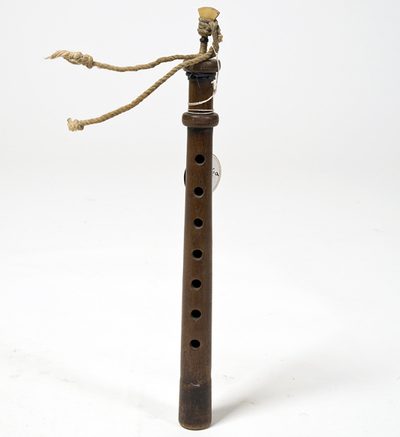hne
Woodwinds
Asia
Between 1001 and 1900 AD
Video
The hne is a traditional double-reed woodwind instrument that plays a vital role in the musical heritage of Myanmar (Burma). Known for its distinctive sound and unique construction, the hne is a key component of the hsaing waing ensemble, which accompanies various cultural rituals, performances, and ceremonies.
The hne (Burmese: နှဲ; also spelled hnè) is a traditional Burmese double-reed wind instrument, similar to a shawm, integral to Myanmar’s musical heritage. The hne is characterized by its conical shape and capped double reed, resembling an oboe but with a more pronounced curvature. Typically made from hardwoods such as rosewood or bamboo, the instrument features several finger holes that allow players to create a range of pitches. The hne is known for its bright, reedy tone that can cut through the ensemble’s sound, making it ideal for both melodic lines and improvisational playing.
Historical Origin
The hne is a traditional double-reed wind instrument from Myanmar (Burma), with significant cultural and musical importance. Its history is deeply intertwined with the country’s rich musical traditions and Buddhist culture. The hne likely traces its origins to ancient Southeast Asian reed instruments, influenced by similar double-reed instruments found in neighboring regions, such as Thailand’s pi nai and Cambodia’s sralai. These instruments, in turn, may have been influenced by the Shawm family of instruments from India, China, and the Middle East, which spread along trade routes like the Silk Road. The hne’s construction and playing style show evidence of these cultural exchanges, combining local craftsmanship with broader regional influences. In Myanmar, the hne became a central instrument in traditional ensembles, particularly in the saing waing, a classical Burmese orchestra.
Its distinct, loud, and piercing tone makes it ideal for outdoor performances and ceremonial music, where it often leads the ensemble. Historically, the hne has been played in religious ceremonies, royal courts, and festivals, reflecting its deep integration into Burmese cultural life. Over time, the instrument has been crafted with local materials, such as hardwood for the body and cane for the reeds, giving it its unique sound and identity within Myanmar’s musical heritage.
Working Mechanism
The hne is a traditional wind instrument, commonly used in Myanmar (Burma), particularly in classical and ceremonial music. It is closely related to other double-reed instruments like the oboe or shawm and has a distinctive, loud, and piercing sound that makes it suitable for outdoor performances and large gatherings.
Sound Production: The player blows air into the reed. The air causes the double reed to vibrate rapidly, creating sound waves. These vibrations travel through the conical bore of the instrument, amplifying the sound.
Pitch Control: The pitch is controlled by opening and closing the finger holes along the body of the instrument. Each hole corresponds to a specific note. The player can also modify pitch slightly through breath control and embouchure (the way the lips interact with the reed).
Timbre: The hne has a distinctively sharp and nasal tone due to the reed and the conical bore, which amplifies higher harmonics. This characteristic timbre makes it easily recognizable in ensemble settings, such as the Hsaing Waing orchestra, where it is commonly used.
Circular Breathing: Advanced players use circular breathing to produce a continuous sound without pauses for inhalation. This is done by simultaneously blowing air stored in the cheeks while inhaling through the nose.
Types
There are different types of hne based on size and pitch:
Hne Gyi: A larger version used for ceremonial compositions.
Hne Kyi Waing: A variant that is often tuned higher for specific musical contexts.
Hne Nyaung: A smaller version suitable for more intimate performances.
Each type serves specific roles within musical compositions, allowing for a diverse range of sounds when played together in ensembles.
Features and Significance
The hne is distinguished by several key features:
This design allows players to produce sound without direct contact with the reeds, resulting in a unique tonal quality. Known for its loud and penetrating tone that can project over large ensembles, making it ideal for outdoor performances. The hne holds significant historical value as it reflects Burmese music practices and social customs. It symbolizes rural life while being part of formal musical settings.
In modern times, interest in early music has led to a revival of instruments like the hne. Contemporary musicians continue to explore its sound within traditional contexts as well as in fusion genres that blend Western elements with Burmese music. The hne is more than just an instrument; it embodies a rich cultural heritage that spans centuries. Its distinctive sound, unique construction, and historical context make it an important part of Myanmar’s musical traditions. Whether played in ceremonial settings or folk performances, the hne continues to captivate musicians and audiences alike with its melodic charm and vibrant history.
FAQ
What is the Hne and its significance in traditional music?
The Hne is a traditional double-reed wind instrument from Myanmar, integral to Burmese classical and folk music. It is known for its loud and vibrant tone, often used in outdoor performances and ceremonial events.
How is the Hne constructed and what materials are used?
The Hne is typically made from hardwood, with a body featuring a conical bore. Its double reed is crafted from palm leaves, and the instrument is adorned with decorative carvings, reflecting its cultural significance.
What are the types of Hne and their differences?
There are two main types of Hne: the Hnegyi (large Hne) and the Hnelay (small Hne). The Hnegyi produces a deeper, more resonant sound, while the Hnelay has a higher pitch and is often used for lighter, faster musical pieces.
 Links
Links
References
Other Instrument
Categories


















